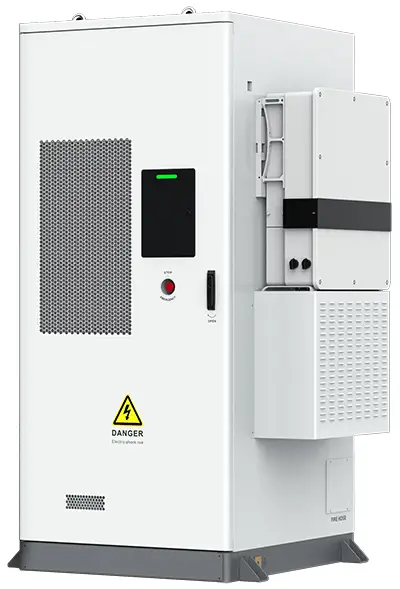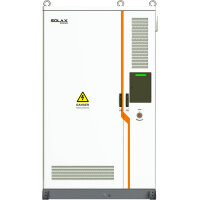Security during power outages through C&I energy storage systems
With increasing digitalization and automated processes, uninterrupted power supplies are becoming increasingly critical for companies. Power outages can cause significant economic damage – from production downtime to data loss and damaged equipment. Commercial & Industrial (C&I) energy storage systems are becoming a key technology to protect companies from the consequences of grid outages and serve as a modern emergency power supply.

Risks and Consequences of Power Outages
Power outages pose a significant risk to companies. In manufacturing, even short interruptions often lead to the shutdown of entire production lines and can cause waste. Sudden power outages damage sensitive machinery and electronics, while IT systems without an uninterruptible power supply can lose data. Failures in security systems such as surveillance, access, and fire protection systems, as well as in sectors with cold chain requirements such as the food and pharmaceutical industries, are particularly critical.
The economic impact is considerable. Studies show that power outages cost the German economy several billion euros annually. For individual companies, depending on the industry, costs can range from a few thousand to several hundred thousand euros per hour of downtime – a risk that can be significantly reduced with reliable emergency power supply systems.
How C&I Energy Storage Systems Work During Power Outages
C&I energy storage systems offer a modern alternative or complement to conventional emergency power generators. Their particular strength lies in their extremely fast response time: Modern battery storage systems detect grid outages within milliseconds. The switchover time between grid operation and stand-alone operation is typically less than 20 milliseconds – too fast to be noticeable for most processes and devices. This response time is significantly shorter than with conventional diesel generators, which often require several seconds to deliver full power.
In the event of a grid failure, the system automatically switches to stand-alone operation. The storage system's inverter creates a stable power grid with a constant frequency and voltage. At the same time, intelligent load management is implemented, prioritizing power to critical consumers while automatically shutting down less important systems. The stored power is used specifically to power the relevant systems to optimally utilize the available energy.
Depending on the configuration and company needs, the emergency power system can implement various supply levels: from short-term bridging for outages lasting seconds to minutes, to the orderly shutdown of critical systems, to long-term power supply for important infrastructure over several hours. In many applications, C&I storage systems are combined with other emergency power solutions, such as diesel generators, where the storage system bridges the generator's start-up time, or with PV systems that can recharge the storage system in stand-alone mode during daytime outages.
Technical Requirements for Emergency Power Supply
Not every C&I storage system is automatically suitable for use as an emergency power supply. A key requirement is black start capability, i.e., the ability to start without an external power source. Grid-forming inverters are also required, which, unlike grid-commutated inverters, can independently establish a stable power grid. The power capacity in kilowatts must be designed for all peak loads of the systems to be supplied, while the storage capacity in kilowatt hours determines the possible bridging duration.
An automated transfer switch with special NA protection (grid and system protection) ensures safe disconnection from the public grid, while selective load shedding relays enable the prioritized supply of critical systems. The technical design of such emergency power supply systems should always be carried out by qualified personnel, taking into account the individual requirements and applicable standards such as VDE-AR-N 4105, to ensure safe and reliable operation.
Security during power outages with C&I energy storage systems
With increasing digitalization and automated processes, uninterrupted power supplies are becoming increasingly critical for companies. Power outages can cause significant economic damage – from production downtime to data loss and damaged equipment. Commercial & Industrial (C&I) energy storage systems are becoming a key technology to protect companies from the consequences of grid outages and serve as a modern emergency power supply.

Risks and Consequences of Power Outages
Power outages pose a significant risk to companies. In manufacturing, even short interruptions often lead to the shutdown of entire production lines and can cause waste. Sudden power outages damage sensitive machinery and electronics, while IT systems without an uninterruptible power supply can lose data. Failures in security systems such as surveillance, access, and fire protection systems, as well as in sectors with cold chain requirements such as the food and pharmaceutical industries, are particularly critical.
The economic impact is considerable. Studies show that power outages cost the German economy several billion euros annually. Depending on the industry, individual companies can incur costs ranging from several thousand to several hundred thousand euros per hour of downtime – a risk that can be significantly reduced with reliable emergency power supply systems.
How C&I Energy Storage Systems Work During Power Outages
C&I energy storage systems offer a modern alternative or complement to conventional emergency power generators. Their particular strength lies in their extremely fast response time: Modern battery storage systems detect grid outages within milliseconds. The switchover time between grid operation and stand-alone operation is typically less than 20 milliseconds – too fast to be noticeable for most processes and devices. This response time is significantly shorter than with conventional diesel generators, which often require several seconds to reach full power.
In the event of a grid failure, the system automatically switches to stand-alone operation. The storage system's inverter creates a stable power grid with a constant frequency and voltage. At the same time, intelligent load management is implemented, prioritizing power to critical consumers while automatically shutting down less important systems. The stored power is used specifically to power the relevant systems to optimally utilize the available energy.
Depending on the configuration and company needs, the emergency power system can implement various supply levels: from short-term bridging for outages lasting seconds to minutes, to the orderly shutdown of critical systems, to long-term power supply for important infrastructure over several hours. In many applications, C&I storage systems are combined with other emergency power solutions, such as diesel generators, where the storage system bridges the generator's start-up time, or with PV systems that can recharge the storage system in stand-alone mode during daytime outages.
Technical Requirements for Emergency Power Supply
Not every C&I storage system is automatically suitable for use as an emergency power supply. An essential requirement is black-start capability, i.e., the ability to start without an external power source. Grid-forming inverters are also required, which, unlike grid-commutated inverters, can independently establish a stable power grid. The power capacity in kilowatts must be designed for all peak loads of the systems to be supplied, while the storage capacity in kilowatt hours determines the possible bridging duration.
An automated transfer switch with special NA protection (grid and system protection) ensures safe disconnection from the public grid, while selective load shedding relays enable the prioritized supply of critical systems. The technical design of such emergency power supply systems should always be carried out by qualified personnel, taking into account the individual requirements and applicable standards such as VDE-AR-N 4105, to ensure safe and reliable operation.
Dimensioning an Emergency Power Storage System
Correct dimensioning is crucial for the effectiveness of the emergency power supply. The process begins with a careful analysis of all critical loads that must be supplied in the event of a power outage. These are categorized by priority, with security systems, server rooms, and critical production areas typically receiving the highest priority. The required power is determined for each priority level, taking into account both the base load and short-term power peaks, such as motor start-ups. Future expansions should also be incorporated into the planning.
Based on historical data on power outages and the criticality of the processes, the desired bridging period is determined, which in turn determines the required storage capacity. For example, if a medium-sized company identifies critical loads of 100 kW that must be supplied for two hours in the event of a power outage, and a recommended depth of discharge of 80% is assumed, the required storage capacity is 250 kWh. Starting currents must also be considered for the inverter power, which typically leads to an oversizing of the power by 20-30%.
Economic Consideration of the Emergency Power Supply
Investing in an emergency-capable C&I storage system should always be subject to a cost-benefit analysis. The investment costs are offset by various benefits: the prevention of production downtime, protection against system damage, possible reductions in insurance premiums, and multiple benefits through combination with other functions. The costs for such an emergency power supply consist of the battery storage (€500-1,000/kWh), grid-forming inverters (about 20-30% more expensive than standard inverters), switching and safety technology, as well as planning and installation.
The economic efficiency improves significantly when the system is used for multiple applications. A typical C&I storage system can be used for self-consumption optimization and peak load management during normal operation, generate additional revenue through grid services, and serve as an emergency power supply in a power outage scenario. Thanks to this multiple benefit, investments can often pay for themselves in 5-8 years, whereas the pure emergency power function alone is rarely economically viable.
Practical Implementation Examples
The practical relevance of reliable emergency power supplies is demonstrated by concrete examples from industry. A medium-sized metalworking company with sensitive CNC machines installed a 200 kWh / 100 kW storage system as part of its emergency power supply strategy. After three short power outages within a year, the company was able to avoid production downtime and machine damage worth an estimated €80,000 – a significant contribution to the amortization of the €170,000 investment in the first year alone. Investment costs.
In another case, a food manufacturer secured its cold chain with a 350 kWh / 150 kW storage system. During a six-hour power outage, the emergency power system, combined with an existing PV system, was able to continuously supply the critical refrigeration units, thus preventing the loss of goods valued at over €200,000. These examples illustrate the concrete economic benefits that modern energy storage systems can provide as part of a reliable emergency power supply.
Dimensioning an emergency power storage system
Correct dimensioning is crucial for the effectiveness of the emergency power supply. The process begins with a careful analysis of all critical loads that must be supplied in the event of a power outage. These are categorized by priority, with security systems, server rooms, and critical production areas typically receiving the highest priority. The required power is determined for each priority level, taking into account both the base load and short-term power peaks, such as motor start-up. Future expansions should also be incorporated into the planning.
Based on historical data on power outages and the criticality of the processes, the desired bridging period is determined, which in turn determines the required storage capacity. For example, if a medium-sized company identifies critical loads of 100 kW that must be supplied for two hours in the event of a power outage, and a recommended depth of discharge of 80% is assumed, the required storage capacity is 250 kWh. Starting currents must also be considered for the inverter power, which typically leads to an oversizing of the power by 20-30%.
Economic Consideration of Emergency Power Supply
Investing in an emergency-capable C&I storage system should always be subject to a cost-benefit analysis. The investment costs are offset by various benefits: the prevention of production downtime, protection against system damage, possible reductions in insurance premiums, and multiple benefits through combination with other functions. The costs for such an emergency power supply consist of the battery storage (€500-1,000/kWh), grid-forming inverters (about 20-30% more expensive than standard inverters), switching and safety technology, as well as planning and installation.
The economic efficiency improves significantly when the system is used for multiple applications. A typical C&I storage system can be used for self-consumption optimization and peak load management during normal operation, generate additional revenue through grid services, and serve as an emergency power supply in a power outage scenario. Thanks to this multiple benefit, investments can often pay for themselves in 5-8 years, whereas the pure emergency power function alone is rarely economically viable.
Practical Implementation Examples
The practical relevance of reliable emergency power supplies is demonstrated by concrete examples from industry. A medium-sized metalworking company with sensitive CNC machines installed a 200 kWh / 100 kW storage system as part of its emergency power supply strategy. After three short power outages within a year, the company was able to avoid production downtime and machine damage worth an estimated €80,000 – a significant contribution to the amortization of the €170,000 investment in the first year alone. Investment costs.
In another case, a food manufacturer secured its cold chain with a 350 kWh / 150 kW storage system. During a six-hour power outage, the emergency power system, combined with an existing PV system, was able to continuously supply the critical refrigeration units, thus preventing the loss of goods valued at over €200,000. These examples illustrate the concrete economic benefits that modern energy storage systems can provide as part of a reliable emergency power supply.
Advantages over conventional emergency power solutions
Compared to conventional emergency power supply solutions, C&I storage systems offer significant advantages. Unlike diesel generators, they respond virtually instantaneously, thus avoiding even the briefest interruptions. While generators require regular testing, fuel storage, and exhaust systems, battery storage systems operate silently, emission-free, and with minimal maintenance. This is a decisive advantage, especially in urban environments or where strict environmental regulations apply.
Conventional UPS (uninterruptible power supply) systems offer similarly fast response times, but their backup time is typically limited to a few minutes. C&I storage systems, on the other hand, can achieve backup times of several hours, depending on their dimensions. The greatest advantage, however, lies in the multiple benefits: While conventional emergency power solutions usually remain unused and simply incur costs, a C&I storage system can contribute to optimizing energy management on a daily basis, thus significantly improving its economic efficiency.
Future Perspectives for Emergency Power Supply
The future of emergency power supply through C&I energy storage systems is shaped by several trends. Technological advances in battery technology lead to higher energy densities, longer service lives, and lower costs, which further improves economic efficiency. AI-supported forecasting systems enable increasingly precise predictions of impending grid instabilities and can initiate preventive measures before an outage even occurs.
The increasing prevalence of decentralized energy producers and the advancing digitalization of power grids are creating new opportunities for resilient energy supply concepts. In the future, local microgrids could be created that automatically switch to island operation in the event of a major grid failure, continuing to supply electricity to multiple companies or entire commercial areas. C&I storage systems would assume a central stabilization function in such scenarios.
Conclusion
C&I energy storage systems offer companies a modern, flexible, and reliable form of emergency power supply that goes far beyond the capabilities of conventional solutions. Their multifunctionality not only improves resilience against power outages but can also contribute to energy cost optimization in daily operations. Continuous technological development and falling costs will make these systems attractive to more and more companies in the future.
In view of increasing extreme weather events and the transition to renewable energies, a reliable emergency power supply is becoming increasingly important. Companies that invest early in modern C&I storage systems not only protect themselves against costly outages, but also position themselves strategically to meet the demands of an increasingly decentralized and volatile energy landscape.
Advantages over conventional emergency power solutions
Compared to conventional emergency power supply solutions, C&I storage systems offer significant advantages. Unlike diesel generators, they respond virtually instantaneously, thus avoiding even the briefest interruptions. While generators require regular testing, fuel storage, and exhaust systems, battery storage systems operate silently, emission-free, and with minimal maintenance. This is a decisive advantage, especially in urban environments or where strict environmental regulations apply.
Conventional UPS (uninterruptible power supply) systems offer similarly fast response times, but their backup time is typically limited to a few minutes. C&I storage systems, on the other hand, can achieve backup times of several hours, depending on their dimensions. The greatest advantage, however, lies in the multiple benefits: While conventional emergency power solutions usually remain unused and simply incur costs, a C&I storage system can contribute to optimizing energy management on a daily basis, thus significantly improving its economic efficiency.
Future Perspectives for Emergency Power Supply
The future of emergency power supply through C&I energy storage systems is shaped by several trends. Technological advances in battery technology lead to higher energy densities, longer service lives, and lower costs, which further improves economic efficiency. AI-supported forecasting systems enable increasingly precise predictions of impending grid instabilities and can initiate preventive measures before an outage even occurs.
The increasing prevalence of decentralized energy producers and the advancing digitalization of power grids are creating new opportunities for resilient energy supply concepts. In the future, local microgrids could be created that automatically switch to island operation in the event of a major grid failure, continuing to supply electricity to multiple companies or entire commercial areas. C&I storage systems would assume a central stabilization function in such scenarios.
Conclusion
C&I energy storage systems offer companies a modern, flexible, and reliable form of emergency power supply that goes far beyond the capabilities of conventional solutions. Their multifunctionality not only improves resilience against power outages but can also contribute to energy cost optimization in daily operations. Continuous technological development and falling costs will make these systems attractive to more and more companies in the future.
In view of increasing extreme weather events and the transition to renewable energies, a reliable emergency power supply is becoming increasingly important. Companies that invest early in modern C&I storage systems not only protect themselves against costly outages, but also position themselves strategically to meet the demands of an increasingly decentralized and volatile energy landscape.














